From Transactions to Intents: Mitosis as the Engine for a New Era of Cross-Chain Interactions
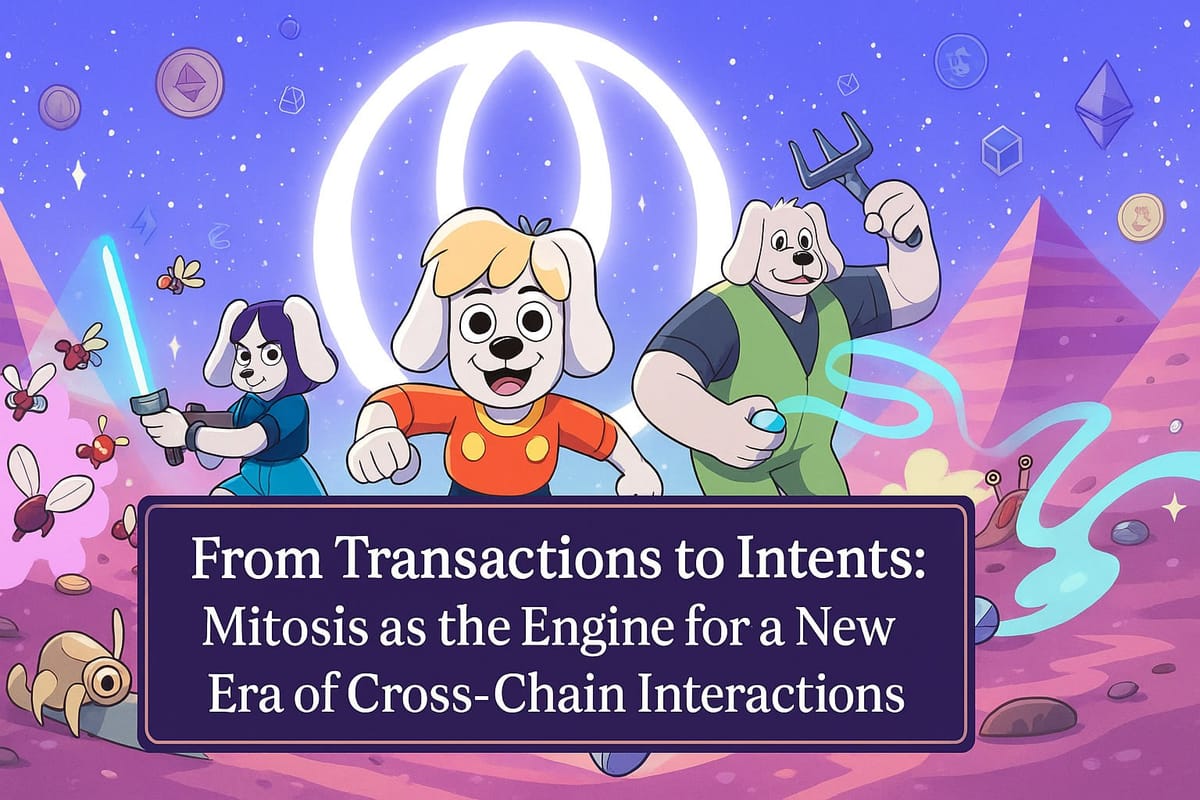
1. Introduction
The Evolution of Web3 Interaction: The Next Step After Transactions
Recall your first steps into the world of decentralized finance (DeFi) or Web3. Most likely, they involved executing specific transactions: signing a token transfer, approving a smart contract to use your funds, swapping one asset for another, adding liquidity to a pool. Each action required understanding the process, choosing the correct network, managing fees (gas), and often, multiple sequential steps. This is the transaction-oriented approach we've grown accustomed to.
However, as the Web3 ecosystem becomes more complex and the number of blockchains grows, this approach is beginning to show its limitations:
- High Barrier to Entry: It's difficult for newcomers to grasp all the nuances of transactions, especially when interacting with multiple networks.
- Poor User Experience (UX): Numerous clicks, confirmations, the need to monitor gas and select bridges – all of this is tiring and off-putting.
- Fragmentation of Opportunities: The best yield or the desired NFT might be on another blockchain, and the user must manually construct a complex chain of transactions to achieve their goal.
- Missed Efficiency: Users may not always find the optimal route for their operations or the best protocol for their needs.
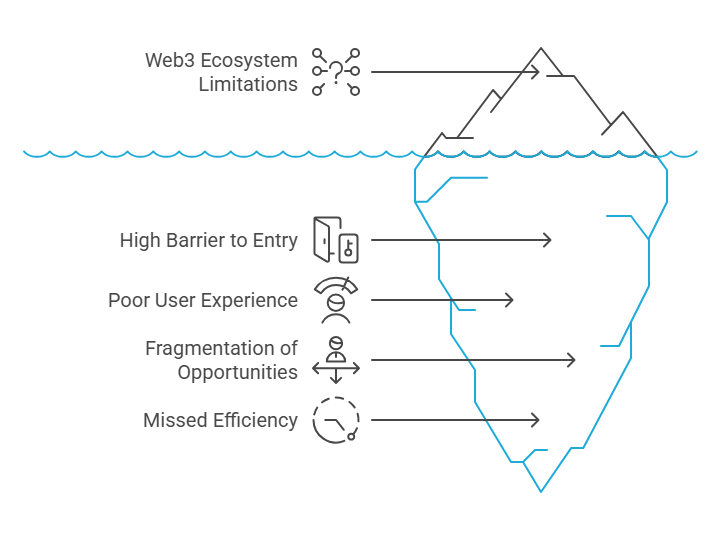
Enter Intents: "What I Want" Instead of "How to Do It"
Against the backdrop of these challenges, a new, more intuitive, and powerful approach to interaction is emerging in Web3 – intent-based architectures. What are they?
An Intent is a declarative expression by the user of their desired end-state, without specifying the concrete steps or transactions to achieve it.
Simply put, the user tells the system:
- "I want to swap my 100 USDC on Ethereum for the maximum amount of SOL on Solana at the best possible rate, considering fees and slippage."
- "I want to stake my 10 ETH for the maximum APY in a reputable protocol, regardless of which network it's on."
- "I want to buy this NFT on marketplace X using my funds in wallet Y on network Z."
And the system (specialized protocols, aggregators, "solvers") then finds the optimal path, executes all necessary transactions (including cross-chain transfers), manages risks, and provides the user with the final result. This is a shift from micromanaging transactions to delegating the execution of complex tasks.
Mitosis: Key Infrastructure for Executing Cross-Chain Intents
Intent-based systems promise to revolutionize the UX in Web3, making it an order of magnitude simpler and more efficient. But for them to function fully, especially when intents involve multiple blockchains, reliable and efficient infrastructure for cross-chain interaction is essential.
This is precisely where Mitosis, with its focus on the secure and efficient movement of liquidity, can play a key role. For a system to execute a user's intent that involves assets or protocols on different networks, it needs a "transport layer" that can:
- Securely move assets between networks.
- Ensure sufficient liquidity to perform operations.
- Do this quickly and with predictable costs.
Mitosis, with its Ecosystem-Owned Liquidity (EOL) model and security mechanisms based on EigenLayer AVS, is ideally suited for the role of such infrastructure.
What Will You Learn From This Article?
In this article, we will explore in detail how Mitosis can become a catalyst for the development of intent-based architectures in Web3:
- We will delve deeper into the concept of intents and their advantages.
- We will analyze the infrastructural challenges facing intent execution systems, especially in a cross-chain context.
- We will show how Mitosis's key features (EOL, security, efficiency) help address these challenges.
- We will look at examples of how Mitosis can be used to create powerful cross-chain intent-based applications and services.
2. Mitosis as the Foundation for Cross-Chain Intent Systems
Intent-based architectures hold immense potential, but their implementation, especially in a multichain environment, faces several serious infrastructural challenges. Let's examine these challenges and how Mitosis helps overcome them.
Challenge #1: Secure and Reliable Asset Movement Between Networks
- The Problem: To execute an intent that involves assets on different blockchains (e.g., "swap ETH on Ethereum for ATOM on Cosmos"), the system needs a way to securely move value from one network to another. Traditional bridges, as we know, are often targets of attacks. If the underlying asset transfer mechanism is vulnerable, the entire intent system is compromised.
- The Mitosis Solution:
- Protocol-Level Security: Mitosis utilizes advanced security mechanisms, such as EigenLayer AVS, to protect its cross-chain operations. This means messages and transactions passing through Mitosis are validated using Ethereum's cryptoeconomic security, making attacks extremely costly and complex. An intent system built on top of Mitosis inherits this high level of security for its cross-chain components.
- Trust Minimization: Instead of relying on centralized intermediaries or small groups of validators, Mitosis strives for trust minimization by relying on economic incentives and decentralized validation.
Challenge #2: Liquidity Availability for Execution
- The Problem: Even if there's a secure way to transmit an intent message, its actual execution (e.g., making a swap) requires liquidity on the destination network. If an intent system simply sends a request to "buy SOL on Solana," but there isn't enough SOL liquidity on Solana against the offered asset, the intent cannot be executed efficiently (or at all).
- The Mitosis Solution:
- Ecosystem-Owned Liquidity (EOL): Mitosis's unique model where the protocol owns and actively manages significant liquidity pools across various networks. This means Mitosis can itself act as a liquidity provider or "market maker" for executing intents, ensuring the necessary assets are available where needed.
- Strategic Liquidity Deployment: The Mitosis Treasury can analyze intent flows and proactively deploy EOL liquidity to those networks and for those assets that are most in demand, thereby increasing the likelihood of successful and efficient execution of user requests.
- Reduced Slippage: Thanks to deep EOL liquidity, Mitosis can facilitate intent execution with lower slippage, which is especially important for large trades.
Challenge #3: Speed and Efficiency of Execution
- The Problem: Intents are often time-sensitive. For example, an intent for an arbitrage trade or participation in a short-term yield farming program requires very fast execution. Slow cross-chain transfers can make such intents unfeasible or unprofitable.
- The Mitosis Solution:
- Optimized Architecture: Mitosis is designed with a focus on the speed and efficiency of cross-chain operations.
- Direct Routes (Potentially): Due to broad network coverage and management of its own liquidity, Mitosis can offer more direct and faster routes for asset movement compared to needing multiple sequential bridges.
Challenge #4: Complexity of Managing Multiple Cross-Chain Interactions
- The Problem: For an intent "solver" tasked with finding the optimal execution path, managing interactions with multiple different bridges, each with its own API, security level, and speed, is an extremely complex task. This increases development complexity and the risk of errors.
- The Mitosis Solution:
- Unified Integration Layer: Mitosis can provide a single, standardized interface (via SDK or API) for accessing cross-chain liquidity and asset transfer functionality. This significantly simplifies the task for developers of intent-based systems, who no longer need to integrate with dozens of different bridges.
- Abstraction of Underlying Networks: Mitosis handles the complexity of interacting with specific blockchains, allowing intent "solvers" to operate at a higher level of abstraction ("move asset X from network A to network B").
Examples of Mitosis Use in Intent Systems
- Intent-Based Cross-Chain DEX Aggregators: A user expresses an intent: "sell token A for token B at the best price across all of Web3." The aggregator finds the optimal path, which may include multiple swaps on different DEXs across different networks, using Mitosis to move assets between these networks.
- Automated Yield Optimizers: A user expresses an intent: "maximize the yield on my stablecoins." The system automatically finds the best pools and lending protocols across different networks and moves funds using Mitosis.
- Wallets with Intent Functionality: A user directly in their wallet says: "Pay for this NFT on Magic Eden (Solana) with my ETH from Arbitrum." The wallet, integrated with an intent system and Mitosis, executes all necessary steps.
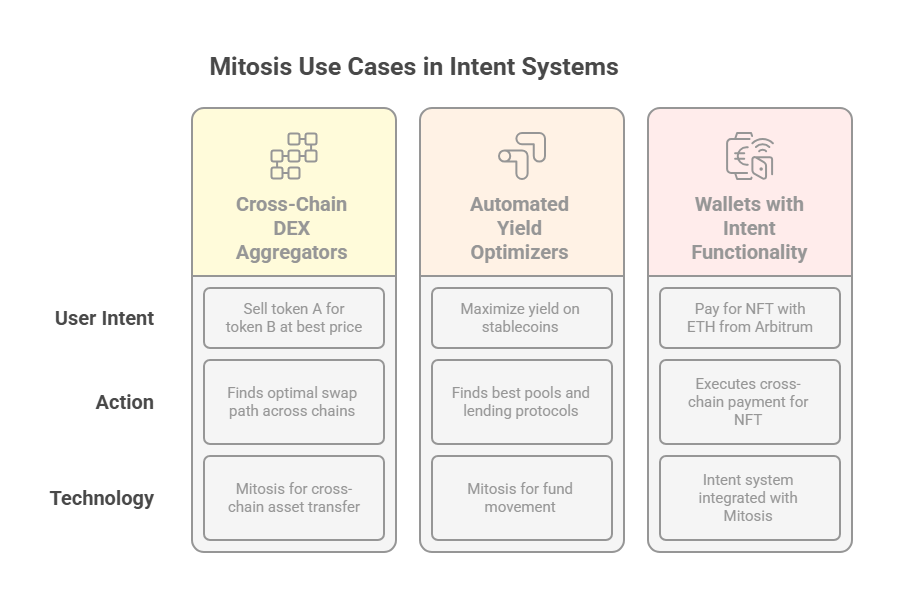
Thus, Mitosis provides critically important building blocks that enable intent-based systems to operate efficiently and securely in the complex multichain world, bringing us closer to a Web3 where technology serves the user, not the other way around.
3. The Future is Intents: Mitosis as a Key Enabler
The Synergy of Mitosis and Intent-Based Systems
It is becoming clear that intent-based architectures and cross-chain liquidity protocols like Mitosis are made for each other. Intents simplify life for the user by abstracting away complexity, while Mitosis provides the reliable and efficient infrastructure "under the hood" so that these intents can be executed across the entirety of Web3.
This synergy paves the way for a new generation of DeFi and Web3 applications:
- Truly User-Centric Applications: Developers will be able to focus on creating intuitive interfaces where users simply express their goals, rather than struggling with technical details.
- Maximum Capital Efficiency: Intent systems, using Mitosis, will be able to automatically find and utilize the best opportunities across Web3, whether it's yield, exchange rates, or other parameters, optimizing users' capital utilization.
- Reduced Experiential Fragmentation: Users will no longer need to "jump" between dozens of applications, bridges, and networks. Their intents will be executed within a single, smooth process.
- New Business Models: New types of services will emerge – "solvers," intent aggregators, specialized protocols for executing specific classes of intents – which will rely on base infrastructure like Mitosis.
Mitosis, by providing liquidity (EOL), security (AVS), and efficient transport, becomes a fundamental layer upon which these innovative intent-based solutions can thrive.
Challenges and Prospects
Despite the enormous potential, there are challenges on the path to mass adoption of intent-based architectures and their full integration with protocols like Mitosis:
- Standardization: Common standards are needed for expressing and interpreting intents so that different systems can interact with each other.
- Development of "Solvers": The creation of complex and efficient "solvers" capable of finding optimal execution paths for intents in a decentralized and competitive environment is required.
- Security of Intent Systems: The intent systems themselves (aggregators, solvers) must be secure and resistant to manipulation.
- User Adoption and Trust: Users will need to get used to a new way of interacting and trust systems to execute their requests.

However, these challenges are surmountable, especially with robust base infrastructure in place. Mitosis, by solving fundamental cross-chain interaction problems, significantly offloads developers of intent systems, allowing them to focus on higher-level logic.
Conclusion: Mitosis – Paving the Way for an Intuitive Web3
The era of intent-based architectures promises to make Web3 significantly more accessible, efficient, and user-oriented. It's a transition from a world where the user must understand the technology to a world where the technology understands the user. And Mitosis plays one of the key roles in this transition.
By providing reliable, secure, and efficient infrastructure for cross-chain liquidity and (potentially) data movement, Mitosis becomes not just a "transport layer," but a fundamental component for executing complex cross-chain intents. It helps turn abstract user desires into concrete results, working silently but effectively "under the hood."
The future of Web3 lies in simplicity and power hidden behind intuitive interfaces. And Mitosis, as an engine for executing user intents, is helping to build precisely such a future – a future where the boundaries between blockchains blur, and the possibilities of the decentralized world become accessible to everyone.
Learn more about Mitosis:
- Explore details on the official website: https://www.mitosis.org/
- Follow announcements on Twitter: https://twitter.com/MitosisOrg
- Participate in discussions on Discord: https://discord.com/invite/mitosis
- Read articles and updates on Medium: https://medium.com/mitosisorg
- Blog: https://blog.mitosis.org/
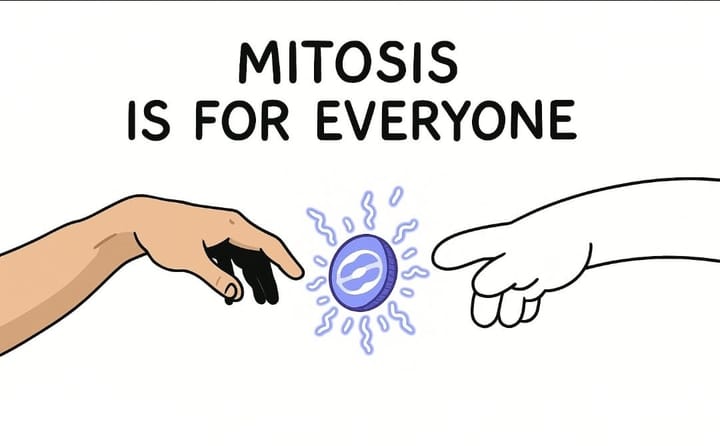
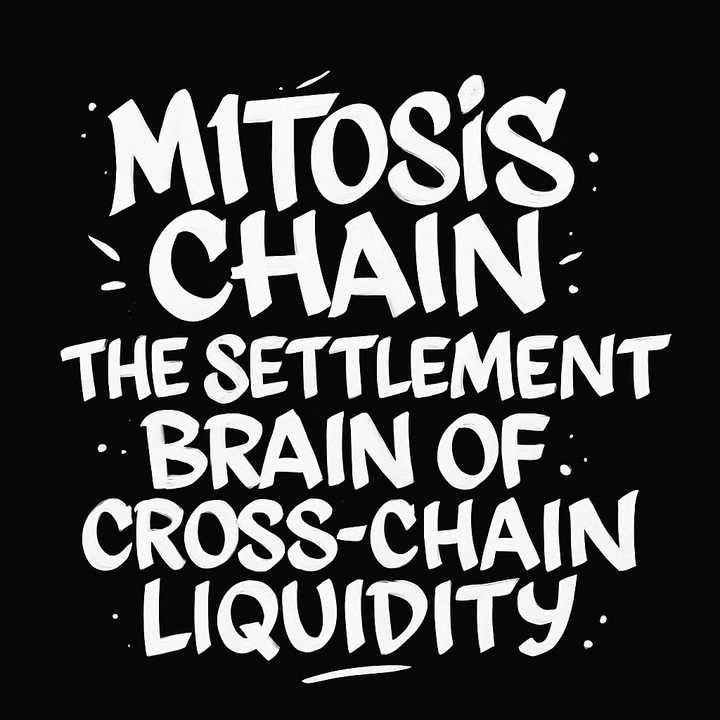
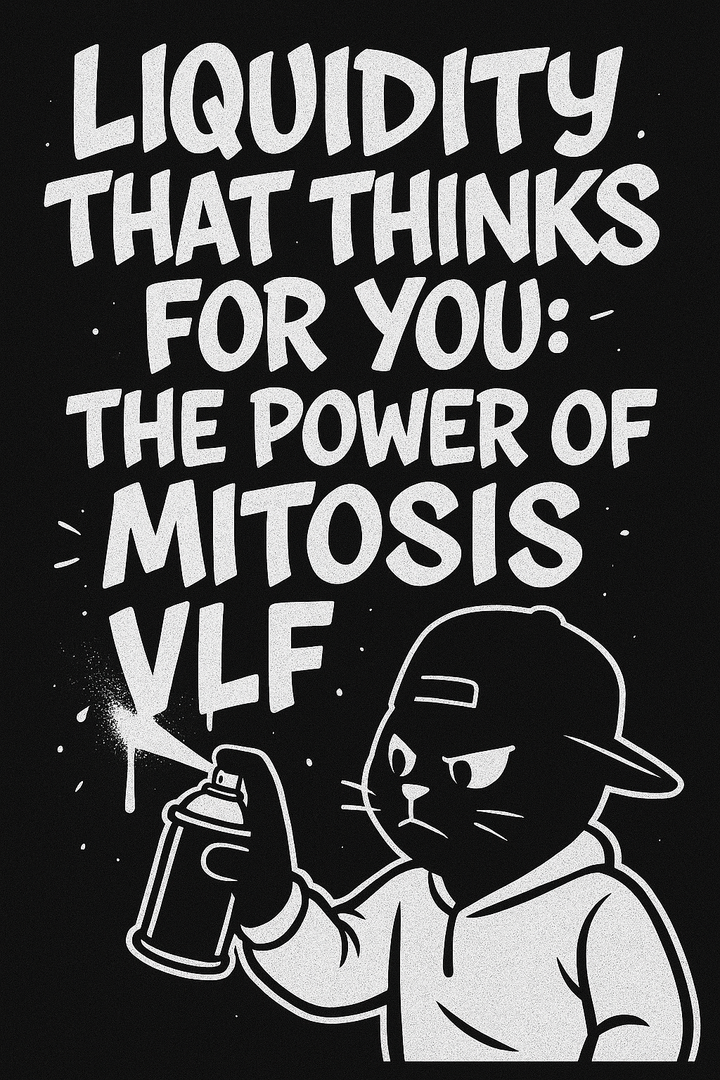
Comments ()